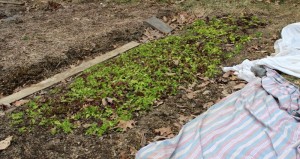We love salads! Lettuce can be part of most every meal and we never get tired of it. That’s why there’s a large patch of it in the front yard where the rest of the garden is. Our plants need sun to grow well and, well, the front yard gets more sun than the back yard, so that’s where we do our planting.
It was an experiment to overwinter the lettuce. We know it’s a cold crop and that lettuces will grow down to 40 degrees Fahrenheit. Any colder than that and their growth is probably very, very slow.
In prior years a collection of windows were stacked around the fall-planted lettuce to extend the growing season. During the autumn the windows made for a nice little hot box heating up the daytime temperatures and protecting the plants at night from frost. Once the bitter cold winter weather came the hot box no longer functioned as one and the lettuce plants went dormant near the end of the calendar year.
Last season instead of the windows we used a sheet, a piece of muslin cloth, and an old sheer curtain to cover the lettuce patch. The muslin and cotton sheet were thicker material than the thin sheer curtain. I didn’t think the sheer material would work as well to protect the plants from freezing weather, but to my surprise it did. All three pieces of cloth material performed their protective duties well.

Even though the ground around the lettuce was frozen and even though these plants under the sheet were covered with snow at times, they survived quite well. Twice in January leaves were cut from these plants for salad and since then they’ve been mostly dormant. They are almost getting warm enough to start re-growing.
The cloth coverings were lifted off the lettuce after each snowfall. It might have been a couple to a few days that the lettuce had to bear the weight of the snow, but when the covers were taken off the plants seemed to fair ok. Sometimes the leaves appeared a little wilted, but that’s nothing that a bowl of icy water can’t take care of, if you want to eat crispier leaves.
The only caution I have is to mention that the weight of the snow on a large piece of material can be quite heavy. With large snowfalls the snow may have to be taken off the coverings with the help of a shovel or old broom. If the snowfall is light, simply flipping the sheets back will work just fine. Sometimes a little snow would get on the plants and that didn’t seem to be a problem.
The dill seed that germinated and started growing in the fall lasted into December. Dill mustn’t be as cold-hardy as the lettuce plants as it disappeared in January.
We successfully overwintered lettuce and will have leaves to cut for the kitchen in a couple of weeks. Yum!